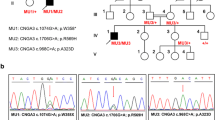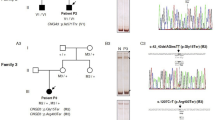Abstract
Achromatopsia (ACHM) or rod monochromacy is an autosomal recessive and genetically heterogeneous retinal disorder. It is characterized by a lack of color discrimination, poor visual acuity, photodysphoria, pendular infantile nystagmus, and abnormal photopic electroretinographic (ERG) recordings with preservation of rod-mediated function. Mutations in three known genes are causative; including genes for the α and β subunits of the cyclic nucleotide-gated cation channel (CNGA3 and CNGB3, respectively) and cone photoreceptor transducin—GNAT2. We investigated the prevalence of mutations in achromatopsia-causing genes in a cohort of 16 families with both clinical and electrophysiologic evidence consistent with autosomal recessive transmission, including one subject with achromatopsia and maternal isodisomy for chromosome 14. The most frequent mutation, p.T383fsX in CNGB3, accounted for 75% (18/24) of disease-associated alleles; intragenic SNPs in unrelated patients revealed transmission of a common haplotype consistent with a founder effect. Homozygous p.T383fsX mutation in CNGB3 that maps to chromosome 8 was detected in a patient with achromatopsia and systemic features associated with uniparental disomy (UPD) of chromosome 14. Two novel variants, p.R223G and p.A621E were found in CNGA3. We conclude that CNGA3 and CNGB3 mutations are responsible for the substantial majority of achromatopsia. Furthermore, the CNGB3 mutation p.T383fsX is a predominant mutation, results from a founder effect, and is responsible for the ACHM in the original clinical report of UPD 14.

Similar content being viewed by others
References
Badano JL, Kim JC, Hoskins BE, Lewis RA, Ansley SJ, Cutler DJ, Castellan C, Beales PL, Leroux MR, Katsanis N (2003) Heterozygous mutations in BBS1, BBS2 and BBS6 have a potential epistatic effect on Bardet–Biedl patients with two mutations at a second BBS locus. Hum Mol Genet 12:1651–1659
Dryja TP (2001) Retinitis pigmentosa and stationary night blindness. In: Scriver CR, Beaudet AL, Sly WS, Valle D, Childs B, Kinzler KW, Vogelstein B (eds) The metabolic and molecular bases of inherited disease. McGraw-Hill, New York, pp 5903–5933
Eichers ER, Lewis RA, Katsanis N, Lupski JR (2004) Triallelic inheritance: a bridge between Mendelian and multifactorial traits. Ann Med 36:262–272
Hodapp JA, Carter GT, Lipe HP, Michelson SJ, Kraft GH, Bird TD (2006) Double trouble in hereditary neuropathy: concomitant mutations in the PMP-22 gene and another gene produce novel phenotypes. Arch Neurol 63:112–117
Johnson S, Michaelides M, Aligianis IA, Ainsworth JR, Mollon JD, Maher ER, Moore AT, Hunt DM (2004) Achromatopsia caused by novel mutations in both CNGA3 and CNGB3. J Med Genet 41:E20
Katsanis N, Ansley SJ, Badano JL, Eichers ER, Lewis RA, Hoskins BE, Scambler PJ, Davidson WS, Beales PL, Lupski JR (2001) Triallelic inheritance in Bardet–Biedl syndrome, a Mendelian recessive disorder. Science 293:2256–2259
Khajavi M, Inoue K, Lupski JR (2006) Nonsense-mediated mRNA decay modulates clinical outcome of genetic disease. Eur J Hum Genet 14:1074–1081
Kohl S, Marx T, Giddings I, Jägle H, Jacobson SG, Apfelstedt-Sylla E, Zrenner E, Sharpe LT, Wissinger B (1998) Total colourblindness is caused by mutations in the gene encoding the alpha-subunit of the cone photoreceptor cGMP-gated cation channel. Nat Genet 19:257–259
Kohl S, Baumann B, Rosenberg T, Kellner U, Lorenz B, Vadalà M, Jacobson SG, Wissinger B (2002) Mutations in the cone photoreceptor G-protein alpha-subunit gene GNAT2 in patients with achromatopsia. Am J Hum Genet 71:422–425
Kohl S, Varsanyi B, Antunes GA, Baumann B, Hoyng CB, Jägle H, Rosenberg T et al (2005) CNGB3 mutations account for 50% of all cases with autosomal recessive achromatopsia. Eur J Hum Genet 13:302–308
Lewis RA (1988) Juvenile hereditary macular dystrophies. In: Newsom DA (eds) Retinal dystrophies and degenerations. Raven, New York, pp 115–134
Lupski JR, Pentao L, Williams LL, Patel PI (1993) Stable inheritance of the CMT1A DNA duplication in two patients with CMT1 and NF1. Am J Med Genet 45:92–96
Meggouh F, de Visser M, Arts WFM, De Coo RIFM, van Schaik IN, Baas F (2005) Early onset neuropathy in a compound form of Charcot–Marie–Tooth disease. Ann Neurol 57:589–591
Michaelides M, Aligianis IA, Ainsworth JR, Good P, Mollon JD, Maher ER, Moore AT, Hunt DM (2004) Progressive cone dystrophy associated with mutation in CNGB3. Invest Ophthalmol Vis Sci 45:1975–1982
Nathans J, Maumenee IH, Zrenner E, Sadowski B, Sharpe LT, Lewis RA, Hansen E, Rosenberg T, Schwartz M, Heckenlively JR et al (1993) Genetic heterogeneity among blue-cone monochromats. Am J Hum Genet 53:987–1000
Nishiguchi KM, Sandberg MA, Gorji N, Berson EL, Dryja TP (2005) Cone cGMP-gated channel mutations and clinical findings in patients with achromatopsia, macular degeneration, and other hereditary cone diseases. Hum Mutat 25:248–258
Peng C, Rich ED, Varnum MD (2003) Achromatopsia-associated mutation in the human cone photoreceptor cyclic nucleotide-gated channel CNGB3 subunit alters the ligand sensitivity and pore properties of heteromeric channels. J Biol Chem 278:34533–34540
Pentao L, Lewis RA, Ledbetter DH, Patel PI, Lupski JR (1992) Maternal uniparental isodisomy of chromosome 14: association with autosomal recessive rod monochromacy. Am J Hum Genet 50:690–699
Potocki L, Chen KS, Koeuth T, Killian J, Iannaccone ST, Shapira SK, Kashork CD, Spikes AS, Shaffer LG, Lupski JR (1999) DNA rearrangements on both homologues of chromosome 17 in a mildly delayed individual with a family history of autosomal dominant carpal tunnel syndrome. Am J Hum Genet 64:471–478
Sharpe LT, Nordby K (1990) Total colour blindness: an introduction. In: Hess RF, Sharpe LT, Nordby K (eds) Night vision: basic, clinical and applied aspects. Cambridge University Press, Cambridge, pp 253–289
Sundin OH, Yang J-M, Li Y, Zhu D, Hurd JN, Mitchell TN, Silva ED, Maumenee IH (2000) Genetic basis of total colourblindness among the Pingelapese islanders. Nat Genet 25:289–293
Sutton VR, Shaffer LG (2000) Search for imprinted regions on chromosome 14: comparison of maternal and paternal UPD cases with cases of chromosome 14 deletion. Am J Med Genet 93:381–387
Trankner D, Jägle H, Kohl S, Apfelstedt-Sylla E, Sharpe LT, Kaupp UB, Zrenner E, Seifert R, Wissinger B (2004) Molecular basis of an inherited form of incomplete achromatopsia. J Neurosci 24:138–147
Wissinger B, Gamer D, Jägle H, Giorda R, Marx T, Mayer S, Tippmann S et al (2001) CNGA3 mutations in hereditary cone photoreceptor disorders. Am J Hum Genet 69:722–737
Acknowledgments
We thank all participating families and their attending physicians for their willing and continued participation in these studies. This study was supported in part by the National Eye Institute, NIH grants EY13255 to J.R.L. R.A.L is a Senior Scientific Investigator for Research to Prevent Blindness, New York, whose unrestricted funds supported part of this research.
Author information
Authors and Affiliations
Corresponding author
Rights and permissions
About this article
Cite this article
Wiszniewski, W., Lewis, R.A. & Lupski, J.R. Achromatopsia: the CNGB3 p.T383fsX mutation results from a founder effect and is responsible for the visual phenotype in the original report of uniparental disomy 14. Hum Genet 121, 433–439 (2007). https://doi.org/10.1007/s00439-006-0314-y
Received:
Accepted:
Published:
Issue Date:
DOI: https://doi.org/10.1007/s00439-006-0314-y




